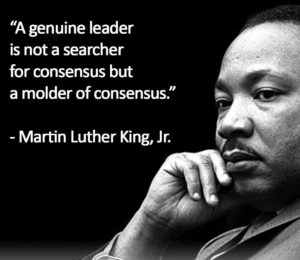 Martin Luther King, Jr. famously stated, “A genuine leader is not a searcher for consensus but a molder of consensus.” As one begins to examine the broad concept of leadership, this idea of molding consensus – of developing an alignment of purpose – is at the heart of its definition; yet, developing an alignment of purpose throughout a department, much less the breadth of an organization, is challenging and requires continuous and conscious engagement. Good or bad, leadership is a driver of an organization’s overall performance. Talent management, individual competency development, and succession planning systems are all critical elements of deepening and diversifying the bench. And while bench strength may begin with focused recruitment and thoughtful hiring processes, it is sustained through company culture and a willingness to invest in high-performing employees. The anatomy of leadership can easily become something that is thought about in the abstract or discussed at length with the appropriate language but without meaningful context; therefore, it’s important that its examination include specifics. Today’s leaders and visionaries have some very challenging and, quite frankly, reflective questions to ask of themselves if they hope to help others achieve success. Are you doing enough to build and maintain a culture of learning that nourishes those who are capable of developing the bench strength vital to this industry? How would you grade your emotional intelligence and self-awareness? And, of course, the most personal consideration: who is your replacement and are you actively engaged in disciplines that support mentorship?
Martin Luther King, Jr. famously stated, “A genuine leader is not a searcher for consensus but a molder of consensus.” As one begins to examine the broad concept of leadership, this idea of molding consensus – of developing an alignment of purpose – is at the heart of its definition; yet, developing an alignment of purpose throughout a department, much less the breadth of an organization, is challenging and requires continuous and conscious engagement. Good or bad, leadership is a driver of an organization’s overall performance. Talent management, individual competency development, and succession planning systems are all critical elements of deepening and diversifying the bench. And while bench strength may begin with focused recruitment and thoughtful hiring processes, it is sustained through company culture and a willingness to invest in high-performing employees. The anatomy of leadership can easily become something that is thought about in the abstract or discussed at length with the appropriate language but without meaningful context; therefore, it’s important that its examination include specifics. Today’s leaders and visionaries have some very challenging and, quite frankly, reflective questions to ask of themselves if they hope to help others achieve success. Are you doing enough to build and maintain a culture of learning that nourishes those who are capable of developing the bench strength vital to this industry? How would you grade your emotional intelligence and self-awareness? And, of course, the most personal consideration: who is your replacement and are you actively engaged in disciplines that support mentorship?


Recent Comments